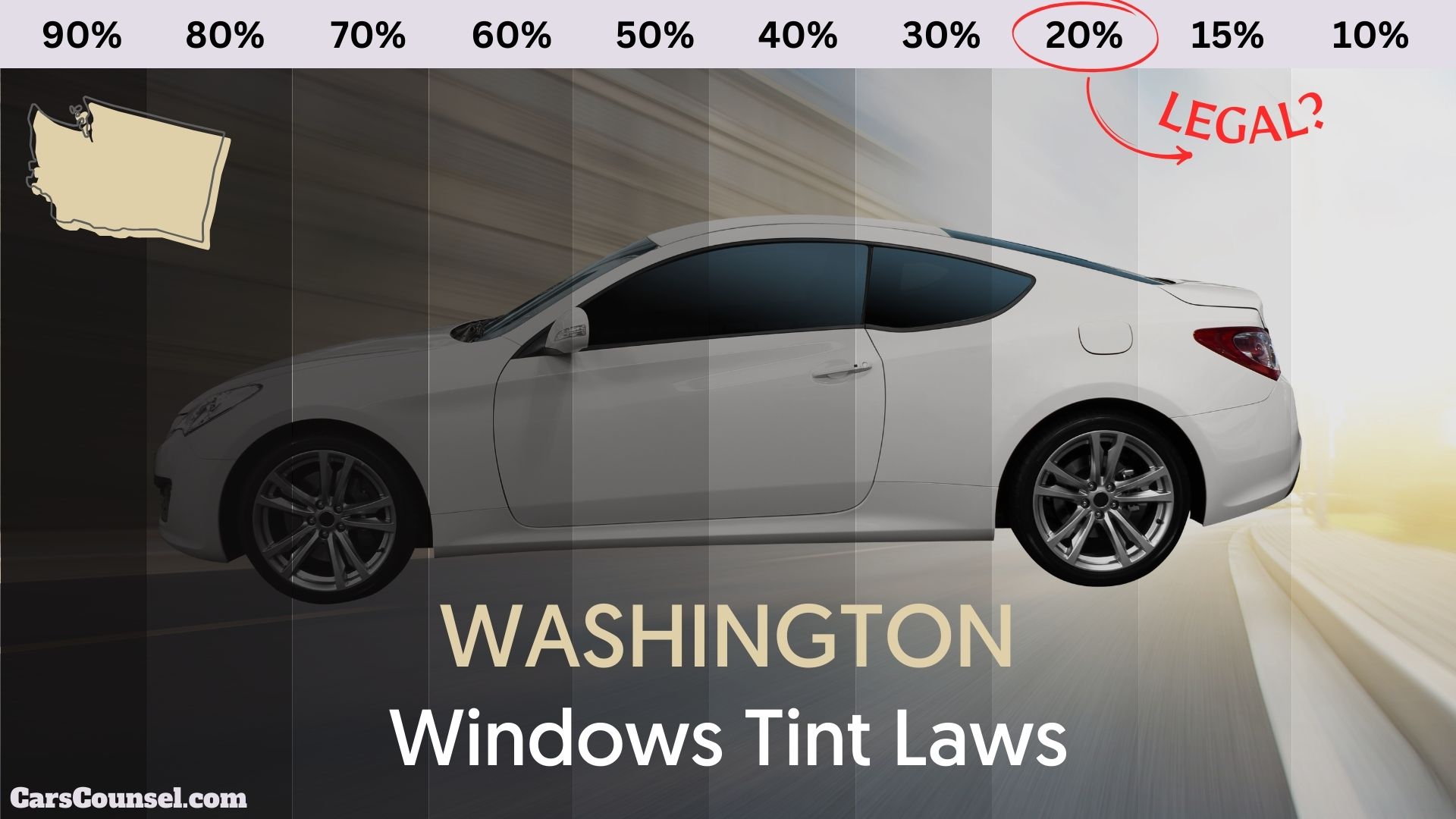As you navigate the Evergreen State’s roads, you may find yourself pondering the wisdom of the ancient Greek playwright Sophocles, who once said, “Look and you shall find what you are looking for.” In this case, you’re probably looking for clarity on Washington’s window tinting laws. Well, you’re in luck.
The state has strict regulations in place to guarantee your vehicle’s tinted windows don’t compromise your visibility or the safety of others on the road. But what exactly do these laws entail, and how can you certify you’re compliant? The answers are just ahead, waiting to be uncovered.

Quick Navigation
Window Tint Darkness in Washington
When it pertains to window tint darkness in Washington, there are specific regulations you need to be aware of to certify adherence with state law.
The Visible Light Transmission (VLT) percentage measures the amount of visible light allowed to pass through the combination of film and window.
For front side windows, you’re required to allow more than 24% of light in, while back side windows and the rear window must also allow more than 24% of light in. This guarantees you can see out and reduce glare.
On the windshield, non-reflective tint is allowed on the top 6 inches, but it can’t reflect incoming light.
Washington window tint rules vary between sedans and SUVs/vans, so make certain you comply with Washington State law and its 3% variance on light meter readings for window tint darkness.
[adinserter block=”17″]
Window Tint Reflection in Washington
As you consider window tint reflection in Washington, you’ll want to guarantee your vehicle’s tint doesn’t exceed the state’s allowed reflectivity levels.
The Washington State laws dictate that the window tint reflection shouldn’t be more than 35% reflective on the windshield and front side windows. This means that at least 65% of visible light must pass through the tint.
It’s essential to comply with these regulations to avoid penalties and certify road safety. Failure to adhere to these laws may result in fines and even vehicle impoundment.
Verify you choose a window tint that meets the state’s reflectivity standards to avoid any issues with law enforcement.
Washington Window Tint Rules
In Washington, specific guidelines govern window tinting to guarantee road safety and compliance with state regulations.
You’re allowed to tint your windshield’s top 6 inches with non-reflective tint, but your front side windows must have a visible light transmission (VLT) of more than 24%.
The same applies to your back side windows and rear window.
Washington law prohibits certain tint colors, including yellow, red, and amber, as well as tints with a mirror-like finish or those that are sprayed on.
Additionally, manufacturers must certify the film they sell in the state, and a sticker is required on your driver’s side window.
Dual side mirrors are also required if you tint your back window.
Visible Light Transmission Requirements
In terms of visible light transmission (VLT) requirements in Washington, you’ll need to follow specific guidelines for your vehicle type.
For sedans, you’re required to have front side windows that allow more than 24% of light in, while back side windows and rear windows must also allow more than 24% of light in.
However, if you own a van or SUV, the VLT requirements differ, with front side windows requiring more than 24% of light in, and back side windows and rear windows having no specific limit in regards to.
VLT Requirements for Sedans
You’re likely wondering about the VLT requirements for sedans in Washington State.
In regards to sedans, the front side windows must allow more than 24% of light to pass through, as measured by the Visible Light Transmission (VLT) percentage.
The same applies to the back side windows and rear window.
In terms of the windshield, it can have a non-reflective tint on the top 6 inches, but the rest can’t be tinted.
Keep in mind that Washington State law allows a 3% variance on light meter readings to account for variations in tint measurement.
The VLT percentage measures the amount of visible light that passes through a window, with most factory glass having a VLT of around 70%.
VLT Requirements for SUVs
Most SUV owners in Washington State want to know the VLT requirements for their vehicles.
You’re likely wondering what’s allowed and what’s not. In regards to SUVs, the rules are slightly different from sedans.
- The front side windows must have a minimum VLT of 24% to guarantee sufficient visible light transmission.
- The back side windows and rear window can have any VLT, but the film mustn’t be mirrored or reflective.
- The tinting laws in Washington require that you have a sticker on the driver’s side window to certify the film’s compliance with state regulations.
- Remember, it’s essential to check with local authorities or a licensed window tinting professional to verify you’re meeting the state’s VLT requirements.
Tinting Placement and Colors
During the window tinting process, one crucial decision you’ll face is where to place the tint and what color to choose. You must guarantee that your window tint complies with Washington state law.
| Window | Tint Color Restrictions |
|---|---|
| Front windshield | No tint allowed above the manufacturer’s AS-1 line |
| Side windows | Tint colors restricted to neutral, amber, and yellow |
| Rear window | No restrictions on tint colors |
| Side mirrors | No tint allowed on side mirrors, certified by the state law to prevent reflections |
Medical Exemptions and Exceptions
Washington’s window tinting regulations are designed to guarantee safety on the roads, but they also provide allowances for individuals with certain medical conditions.
You may be eligible for a medical exemption if you have a condition that requires special tint. Washington allows medical exemptions for special circumstances, and you can apply for an exemption through the Department of Licensing.
- Washington allows medical exemptions for individuals with severe light sensitivity or other conditions that require special tint.
- Exceptions for special tint are granted on a case-by-case basis, so you’ll need to provide documentation from a medical professional.
- Window: Must allow at least 70% of visible light to pass through, even with the special tint.
- Side windows: Must allow at least 40% of visible light to pass through, and you’ll need dual side mirrors to certify safe driving.
Tint Law References
Revised Code of Washington section 46.37.430: Safety glazing – sunscreening or coloring
Car Window Tinting Laws By State
Click on the state you’re interested in for a complete guide to its tint laws and regulations. If you spot any errors, let us know through our contact page.
| State | Front Side Windows | Back Side Windows | Rear Windows | Windshield |
|---|---|---|---|---|
| Alabama | 32% | 32% | 32% | 6 inches |
| Alaska | 70% | 40% | 30% | 5 inches |
| Arizona | 33% | ANY | ANY | tinting allowed to the top of the manufacturer’s as-1 line |
| Arkansas | 25% | 25% | 10% | 5 inches |
| California | 70% | ANY | ANY | 4 inches |
| Colorado | 27% | 27% | 27% | 4 inches |
| Connecticut | 35% | 35% | ANY | non-reflective tint above the as-1 line top 6 inches |
| Delaware | 70% | ANY | ANY | non-reflective tint above the as-1 line top 6 inches |
| Florida | 28% | 15% | 15% | non-reflective tint above the as-1 line |
| Georgia | 32% | 32% | 32% | 6 inches |
| Hawaii | 35% | 35% | 35% | Non-reflective tint is allowed on the top 4 inches of the windshield |
| Idaho | 35% | 20% | 20% | non-reflective tint above the as-1 line |
| Illinois | 35% | 35% | 35% | 6 inches |
| Indiana | 30% | 30% | 30% | non-reflective tint above the as-1 line |
| Iowa | 70% | ANY | ANY | non-reflective tint above the as-1 line |
| Kansas | 35% | 35% | 35% | non-reflective tint above the as-1 line |
| Kentucky | 35% | 18% | 18% | non-reflective tint above the as-1 line |
| Louisiana | 40% | 25% | 12% | non-reflective tint above the as-1 line top 6 inches |
| Maine | 35% | 35% | 35% | top 4 inches |
| Maryland | 35% | 35% | 35% | top 5 inches |
| Massachusetts | 35% | 35% | 35% | top 6 inches |
| Michigan | 35% | ANY | ANY | top4 inches |
| Minnesota | 50% | 50% | 50% | Top 6 inches |
| Mississippi | 28% | 28% | 28% | non-reflective tint above the as-1 line top 5 inches |
| Missouri | 35% | ANY | ANY | non-reflective tint above the as-1 line top 6 inches |
| Montana | 24% | 14% | 14% | non-reflective tint above the as-1 line top 6 inches |
| Nebraska | 24% | 20% | 20% | top 6 inches or as-1 line, whichever comes first |
| Nevada | 35% | ANY | ANY | non-reflective tint above the as-1 line top 6 inches |
| New Hampshire | 35% | 35% | 35% | Allowed for the manufacturer’s AS-1 line |
| New Jersey | Illegal | ANY | ANY | Top 6 inches |
| New Mexico | 20% | 20% | 20% | 5 inches or as-1 line, whichever comes first |
| New York | 70% | 70% | 70% | top 6 inches |
| North Carolina | 35% | 35% | 35% | non-reflective tint above the as-1 line top 6 inches |
| North Dakota | 50% | ANY | ANY | Top 6 inches |
| Ohio | 50% | ANY | ANY | Top 5 inches |
| Oklahoma | 25% | ANY | ANY | 5 inches or as-1 line, whichever comes first |
| Oregon | 35% | 35% | 35% | Top 6 inches |
| Pennsylvania | 70% | 70% | 70% | Top 3 inches |
| Rhode Island | 70% | 35% | 35% | non-reflective tint above the as-1 line top 6 inches |
| South Carolina | 27% | 27% | 27% | non-reflective tint above the as-1 line top 6 inches |
| South Dakota | 35% | 20% | 20% | non-reflective tint above the as-1 line top 6 inches |
| Tennessee | 35% | 35% | 35% | non-reflective tint above the as-1 line top 6 inches |
| Texas | 25% | 25% | 25% | 5 inches or as-1 line, whichever comes first |
| Utah | 43% | ANY | ANY | non-reflective tint above the as-1 line top 4 inches |
| Vermont | 70% | ANY | ANY | ILLEGAL |
| Virginia | 50% | 35% | 35% | non-reflective tint above the as-1 line top 6 inches |
| Washington | 24% | 24% | 24% | Top 6 inches |
| West Virginia | 35% | 35% | 35% | Top 5 inches |
| Wisconsin | 50% | 35% | 35% | non-reflective tint above the as-1 line top 6 inches |
| Wyoming | 28% | 28% | 28% | Top 5 inches or as-1 line, whichever comes first |

